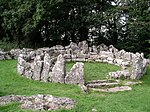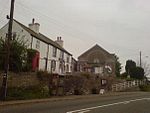Lligwy Bay
Anglesey geography stubsBays of AngleseyMoelfre, Anglesey

Lligwy Bay (Welsh: Traeth Lligwy) is a bay of the Welsh island of Anglesey.It is on the north east of the island, to the north of the village of Moelfre. It was the site, in October 1859, of the loss of the steam clipper Royal Charter with a loss of life in excess of 450. The bay is very popular with windsurfers and other windpowered watersport enthusiasts. There is a pay and display car park at the end of the access road from the A5025 at Brynrefail.
Excerpt from the Wikipedia article Lligwy Bay (License: CC BY-SA 3.0, Authors, Images).Lligwy Bay
Lligwy Beach Lane,
Geographical coordinates (GPS) Address Nearby Places Show on map
Geographical coordinates (GPS)
| Latitude | Longitude |
|---|---|
| N 53.36204 ° | E -4.2601 ° |
Address
Lligwy
Lligwy Beach Lane
LL72 8NL , Moelfre
Wales, United Kingdom
Open on Google Maps









